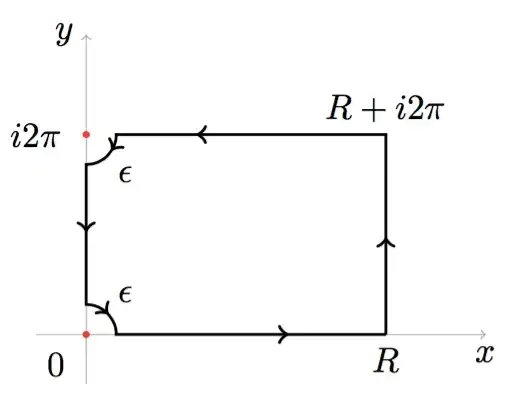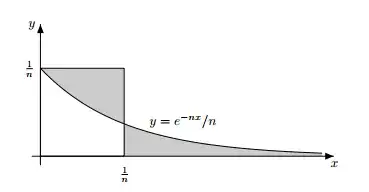As requested by the OP, this is a detailed answer on how to calculate the integral in the final equality of Robert Israel's post, which is
$$
\sum\limits_{n=1}^\infty \frac{1}{n^4} = -\int_0^\infty \frac{w^2}{2}\log(1-e^{-w})\mathrm{d}w.
$$
First integrate by parts with $u=\log(1-e^{-w})$, $v'=w^2/2$. This gives
$$
\phantom{texttext} \sum\limits_{n=1}^\infty \frac{1}{n^4} = -\underbrace{\frac{1}{6} w^3 \log(1-e^{-w})|_0^\infty}_{=0} + \frac{1}{6} \underbrace{\int_0^\infty \frac{w^3}{e^w-1} \mathrm{d}w}_{\equiv J}.\phantom{texttext} (1)
$$
Now the remaining task is to compute the integral $J$.
..............................................................................................................................................................................
This can be done by contour integration as explained in the second answer to the question "Contour integral for $x^3/(e^x-1)$?" (hereafter OA) . In order for the present answer to be as self-contained as possible, I will restate the answer given in the thread I linked (I give all credit to the author of the OA, the following derivation closely follows his and I recommend you read the OA). If it is not acceptable to restate an existing answer, I will remove this part.
Step 1: Choose the following contour, let's call it $\Gamma$, (figure source: OA)
 $\phantom{texexexexexexxt}$
Step 2: Consider the integral
$$
\oint_\Gamma \frac{z^4}{e^z-1} \mathrm{d}z,
$$
which vanishes by Cauchy's theorem because $\Gamma$ is closed and the integrand is analytic. Writing out the contributions of the four edges and the two circle segments,
$\phantom{texexexexexexxt}$
Step 2: Consider the integral
$$
\oint_\Gamma \frac{z^4}{e^z-1} \mathrm{d}z,
$$
which vanishes by Cauchy's theorem because $\Gamma$ is closed and the integrand is analytic. Writing out the contributions of the four edges and the two circle segments,
$$
\int_\epsilon ^R \frac{x^4}{e^x - 1}\mathrm{d}x + \int_0 ^{2\pi} \frac{(R+iy)^4}{e^{R+iy}- 1}i\mathrm{d}y + \int_{R}^\epsilon \frac{(x+i2\pi)^4}{e^{x+i2\pi}-1}\mathrm{d}x + \int_0 ^{-\frac{\pi}{2}}\frac{(2 \pi i + \epsilon e^{i\theta})^4}{e^{2\pi i + \epsilon e^{i\theta}}-1} i\epsilon e^{i\theta}\mathrm{d}\theta + \int_{2\pi- \epsilon}^{\epsilon}\frac{(iy)^4}{e^{iy}-1}i\mathrm{d}y+ \int_{\frac{\pi}{2}}^{0}\frac{(\epsilon e^{i\theta})^4}{e^{\epsilon e^{i\theta}}-1}i\epsilon e^{i\theta} \mathrm{d}\theta = 0.
$$
Step 3: Take the limit $R\to\infty$ and $\epsilon\to 0$. This eliminates the second and last terms respectively. Care must be taken in the 4th integral, because $\epsilon\to 0$ cannot be taken straightforwardly. Rather, use $\lim_{x\to0}x/(e^{ax}-1)=1/a$ to find that the 4th integral becomes $-8i\pi^5$. Next expand the power in the third term and note that the $x^4$ term cancels with the first integral. Splitting the 5th integral into real and imaginary parts leaves us with the equation
$$
-i8\pi \int_0 ^\infty \frac{x^3}{e^x - 1} \mathrm{d}x + 24\pi^2\int_0 ^\infty \frac{x^2}{e^x -1}\mathrm{d}x + i 32 \pi^3 \int_0 ^\infty \frac{x}{e^x - 1}\mathrm{d}x- 16\pi^4\int_0 ^\infty \frac{1}{e^x - 1}\mathrm{d}x -i8\pi^5+\frac{i}{2} \int_0 ^{2\pi} y^4 \mathrm{d}y - \frac{1}{2} \int_0 ^{2\pi} \frac{y^4 \sin y}{1-\cos y}\mathrm{d}y=0.
$$
Step 4: Take the imaginary part to find
$$
-8 \pi J + 32 \pi^3 \int_0 ^\infty \frac{x}{e^x - 1}\mathrm{d}x - 8\pi^5+\frac{16\pi^5}{5} = 0
$$
The remaining integral is shown, by the classic trick in the accepted answer to the linked question to be
$$
\int_0^\infty \frac{x}{e^x-1} \mathrm{d}x = \zeta(2).
$$
The value of $\zeta(2)=\pi^2/6$ has been given in the question (it is incorrectly stated in the OA as $\pi^2/12$. This gives the final result
$$
J = \frac{\pi^4}{15},
$$
which, by (1), completes the proof that $\zeta(4)=\pi^4/90 \text{ }\square$.


